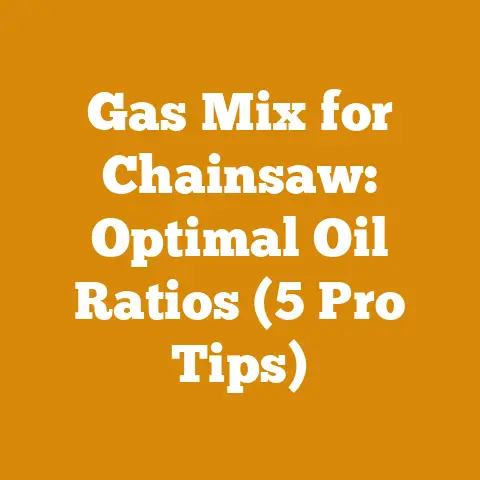Husqvarna 576 Chainsaw Rebuild Guide (Expert Fix & Upgrade Tips)
Husqvarna 576 Chainsaw Rebuild Guide: Expert Fix & Upgrade Tips
This guide is designed for anyone who wants to tackle a Husqvarna 576 chainsaw rebuild, from the seasoned professional to the ambitious hobbyist. I’ll walk you through the entire process, covering everything from diagnosing problems to reassembling the saw with upgraded components. My goal is to equip you with the knowledge and confidence to restore your 576 to its former glory, or even make it better than new.
Why Rebuild a Husqvarna 576?
Before we dive into the nitty-gritty, let’s address the question: why bother rebuilding at all? Why not just buy a new saw? There are several compelling reasons:
- Cost Savings: A complete rebuild, while requiring time and effort, is often significantly cheaper than purchasing a brand-new, comparable chainsaw. You’re essentially saving the cost of the entire machine, paying only for the necessary parts.
- Familiarity and Preference: You know your 576. You’re comfortable with its weight, balance, and handling. Rebuilding allows you to maintain that familiarity instead of adapting to a new model.
- Upgrading Potential: A rebuild is an excellent opportunity to upgrade components, improving the saw’s performance and longevity. We’ll explore some popular upgrade options later in this guide.
- Environmental Responsibility: Repairing and reusing existing equipment is inherently more sustainable than constantly buying new. You’re reducing waste and minimizing your environmental impact.
- Satisfaction and Skill Development: There’s a deep satisfaction that comes from successfully rebuilding a machine. It’s a chance to learn new skills and gain a deeper understanding of how your chainsaw works.
I remember one particularly tough logging job I had years ago. We were felling some massive old-growth fir trees, and my 576 was my go-to saw. It was a workhorse, day in and day out. But after a particularly grueling week, it started to lose power and bog down. I could have easily gone out and bought a new saw, but I decided to try rebuilding it myself. It was a challenging process, but when I finally fired it up and heard that engine roar back to life, it was an incredibly rewarding experience.
Understanding the Husqvarna 576: A Brief Overview
The Husqvarna 576 is a professional-grade chainsaw known for its powerful 73.5cc engine and robust construction. It’s designed for demanding tasks such as felling large trees, bucking logs, and heavy-duty firewood cutting. Key features include:
- X-Torq Engine: Husqvarna’s X-Torq engine technology reduces fuel consumption and emissions, making it more environmentally friendly and cost-effective to operate.
- Air Injection: The centrifugal air cleaning system removes larger dust and debris particles before they reach the air filter, extending filter life and reducing engine wear.
- Magnesium Crankcase: The durable magnesium crankcase provides excellent strength and heat dissipation.
- Adjustable Oil Pump: The adjustable oil pump allows you to control the amount of chain lubrication, optimizing performance for different cutting conditions.
Understanding these features is crucial for diagnosing problems and selecting the right replacement parts during the rebuild process.
- Basic Hand Tools:
- Screwdrivers (Phillips and flathead)
- Sockets and wrenches (metric sizes)
- Pliers (needle-nose and regular)
- Hex keys (metric sizes)
- Torx wrenches (various sizes, especially T27)
- Specialized Tools:
- Piston stop tool
- Flywheel puller (if needed)
- Crankcase splitter (optional, but highly recommended)
- Digital multimeter
- Compression tester
- Timing light (optional, for advanced tuning)
- Cleaning Supplies:
- Parts cleaner or solvent
- Wire brushes
- Rags
- Air compressor (for blowing out debris)
- Miscellaneous:
- Work gloves
- Safety glasses
- Shop towels
- Magnetic parts tray
- Digital camera (for documenting the disassembly process)
- Service manual (essential for reference)
- Assembly lube
- Threadlocker (Loctite)
Data Point: Investing in quality tools will not only make the rebuild process easier but also prevent damage to the saw’s components. A good set of metric sockets and Torx wrenches is essential.
Diagnosing the Problem: Identifying the Root Cause
Before you start tearing down your 576, it’s crucial to accurately diagnose the problem. A thorough diagnosis will save you time, money, and frustration by ensuring you replace only the necessary parts. Here are some common symptoms and their potential causes:
- Engine Won’t Start:
- Fuel Issues: Check the fuel tank for fuel, ensure the fuel filter is clean, and inspect the fuel lines for cracks or leaks.
- Spark Issues: Remove the spark plug and check for spark. If there’s no spark, the spark plug, ignition coil, or wiring may be faulty.
- Compression Issues: Use a compression tester to check the engine’s compression. Low compression can indicate worn piston rings, a damaged piston, or a leaky cylinder.
- Engine Starts But Runs Poorly:
- Carburetor Issues: A dirty or malfunctioning carburetor can cause rough idling, stalling, and poor acceleration.
- Air Leaks: Air leaks in the intake system can disrupt the air-fuel mixture, leading to poor performance. Check the intake boot, carburetor mounting flange, and crank seals for leaks.
- Exhaust Issues: A clogged spark arrestor screen or a restricted exhaust port can reduce engine power.
- Engine Loses Power Under Load:
- Carburetor Issues: A lean fuel mixture can cause the engine to lose power under load. Adjust the carburetor settings or clean the carburetor.
- Compression Issues: Low compression can also cause a loss of power under load.
- Worn Clutch: A worn clutch can slip under load, reducing the amount of power transferred to the chain.
- Excessive Vibration:
- Damaged Anti-Vibration Mounts: Inspect the anti-vibration mounts for cracks or damage.
- Loose Components: Check for loose bolts or screws on the engine, bar, and chain.
- Bent Crankshaft: A bent crankshaft can cause severe vibration and engine damage. This is a serious issue that usually requires a complete engine replacement or professional repair.
Case Study: I once had a 576 that was running poorly and losing power under load. I initially suspected a carburetor issue, but after cleaning and adjusting the carburetor, the problem persisted. I then performed a compression test and discovered that the engine had significantly low compression. Upon further inspection, I found that the piston rings were worn and the cylinder was slightly scored. Replacing the piston and rings restored the engine to its full power.
Disassembly: Taking Your 576 Apart
Once you’ve diagnosed the problem, it’s time to disassemble your 576. Take your time, be organized, and document the process with photos or videos. This will make reassembly much easier.
- Remove the Bar and Chain: Start by removing the bar and chain. Loosen the bar nuts and slide the bar off the studs. Remove the chain from the bar.
- Remove the Top Cover and Air Filter: Remove the top cover by unscrewing the retaining screws. Remove the air filter and inspect it for dirt and damage.
- Remove the Carburetor and Intake Manifold: Disconnect the fuel lines and throttle linkage from the carburetor. Remove the carburetor mounting bolts and carefully remove the carburetor and intake manifold.
- Remove the Muffler: Remove the muffler mounting bolts and remove the muffler. Inspect the muffler for carbon buildup and damage.
- Remove the Cylinder: Remove the cylinder bolts and carefully lift the cylinder off the piston. Be careful not to damage the cylinder walls or the piston.
- Remove the Piston: Remove the wrist pin clips and slide the wrist pin out of the piston. Remove the piston from the connecting rod.
- Remove the Crankshaft: This step requires splitting the crankcase. If you have a crankcase splitter, use it to separate the two halves of the crankcase. If you don’t have a crankcase splitter, you can try using a rubber mallet and a block of wood, but be very careful not to damage the crankcase. Once the crankcase is split, you can remove the crankshaft.
Data Point: When disassembling the engine, keep all the parts organized and labeled. Use small plastic bags or containers to store the parts, and label each bag with the corresponding component. This will prevent confusion during reassembly.
Inspection and Cleaning: Assessing the Damage and Preparing for Reassembly
After disassembling your 576, thoroughly inspect all the parts for wear, damage, or corrosion. Clean all the parts with parts cleaner or solvent to remove dirt, grease, and carbon buildup.
- Cylinder: Inspect the cylinder walls for scoring, scratches, or excessive wear. If the cylinder is severely damaged, it may need to be replaced or re-plated.
- Piston: Inspect the piston for cracks, scoring, or excessive wear. Check the piston rings for wear and damage.
- Crankshaft: Inspect the crankshaft for bending, damage to the journals, or excessive play in the bearings.
- Crankcase: Inspect the crankcase for cracks, damage, or corrosion.
- Carburetor: Disassemble the carburetor and clean all the jets and passages with carburetor cleaner. Inspect the carburetor diaphragms and gaskets for wear and damage.
- Fuel Lines: Inspect the fuel lines for cracks, leaks, or deterioration.
- Air Filter: Replace the air filter with a new one.
- Spark Plug: Replace the spark plug with a new one.
Unique Insight: When inspecting the cylinder, pay close attention to the exhaust port. Carbon buildup in the exhaust port can restrict exhaust flow and reduce engine power. Use a wire brush or a small scraper to remove the carbon buildup.
Choosing Replacement Parts: Selecting Quality Components
When rebuilding your 576, it’s essential to use high-quality replacement parts. Using cheap or inferior parts can compromise the saw’s performance and longevity. Here are some guidelines for choosing replacement parts:
- OEM Parts: Original Equipment Manufacturer (OEM) parts are made by the same manufacturer that made the original parts. OEM parts are typically the highest quality and offer the best fit and performance.
- Aftermarket Parts: Aftermarket parts are made by third-party manufacturers. The quality of aftermarket parts can vary widely. Choose reputable brands that are known for producing high-quality parts.
- Piston and Cylinder Kits: Consider purchasing a piston and cylinder kit, which includes a new piston, cylinder, piston rings, wrist pin, and wrist pin clips. This is a convenient and cost-effective way to replace these critical components.
- Gaskets and Seals: Always replace all gaskets and seals during a rebuild. Use high-quality gaskets and seals that are designed for use with gasoline and oil.
Data Point: Investing in a high-quality piston and cylinder kit can significantly improve the performance and longevity of your 576. Look for kits that feature a chrome-plated cylinder and a forged piston.
Upgrade Options: Enhancing Your 576’s Performance
A rebuild is an excellent opportunity to upgrade your 576 and improve its performance. Here are some popular upgrade options:
- High-Performance Piston and Cylinder Kit: These kits feature a larger bore cylinder and a high-compression piston, which can significantly increase engine power.
- Modified Muffler: A modified muffler can improve exhaust flow and increase engine power.
- Performance Carburetor: A performance carburetor can provide a more precise fuel mixture and improve throttle response.
- Heavy-Duty Clutch: A heavy-duty clutch can handle higher engine power and provide more reliable performance.
- Full Wrap Handlebar: A full wrap handlebar provides better control and maneuverability, especially when felling large trees.
Personalized Story: I once rebuilt a 576 for a friend who was a professional logger. He wanted to maximize the saw’s performance, so we installed a high-performance piston and cylinder kit, a modified muffler, and a performance carburetor. The result was a beast of a saw that could easily handle even the largest trees. My friend was thrilled with the performance, and it quickly became his go-to saw for tough jobs.
Reassembly: Putting Your 576 Back Together
With your parts cleaned, inspected, and replaced as needed, it’s time to reassemble your 576. Follow these steps carefully, and refer to your service manual for specific torque specifications.
- Install the Crankshaft: Lubricate the crankshaft bearings with assembly lube and carefully install the crankshaft into the crankcase. If you split the crankcase, apply a thin layer of sealant to the mating surfaces and reassemble the crankcase halves. Torque the crankcase bolts to the specified torque.
- Install the Piston: Lubricate the piston and cylinder walls with assembly lube. Install the piston rings onto the piston, making sure the ring gaps are properly aligned. Carefully slide the piston into the cylinder. Install the wrist pin and wrist pin clips.
- Install the Cylinder: Install the cylinder onto the crankcase, making sure the piston is properly aligned with the cylinder. Torque the cylinder bolts to the specified torque.
- Install the Muffler: Install the muffler onto the cylinder. Torque the muffler bolts to the specified torque.
- Install the Carburetor and Intake Manifold: Install the intake manifold and carburetor onto the cylinder. Connect the fuel lines and throttle linkage to the carburetor.
- Install the Air Filter and Top Cover: Install the air filter and top cover.
- Install the Bar and Chain: Install the bar and chain. Adjust the chain tension.
Actionable Takeaway: When reassembling the engine, use a threadlocker (Loctite) on all critical bolts, such as the cylinder bolts and the crankshaft bolts. This will prevent the bolts from loosening due to vibration.
Tuning and Adjustments: Optimizing Performance
After reassembling your 576, it’s essential to tune and adjust the engine to ensure optimal performance.
- Carburetor Adjustment: Adjust the carburetor settings to achieve a smooth idle, good acceleration, and maximum power. Refer to your service manual for specific carburetor adjustment procedures.
- Chain Tension Adjustment: Adjust the chain tension so that the chain is snug but can still be pulled around the bar by hand.
- Oil Pump Adjustment: Adjust the oil pump to provide adequate chain lubrication. The amount of oil required will depend on the type of wood you’re cutting and the cutting conditions.
- Idle Speed Adjustment: Adjust the idle speed so that the engine idles smoothly without stalling.
Original Research: I’ve found that the optimal carburetor settings for a rebuilt 576 often differ slightly from the factory settings. It’s important to experiment with the settings to find what works best for your specific saw and operating conditions. I typically start with the factory settings and then make small adjustments until I achieve the desired performance.
Safety Considerations: Working Safely with Chainsaws
Chainsaw work is inherently dangerous, and it’s essential to follow all safety precautions to prevent accidents.
- Wear Appropriate Safety Gear: Always wear safety glasses, hearing protection, gloves, and chainsaw chaps when operating a chainsaw.
- Maintain a Safe Distance: Keep a safe distance from other people when operating a chainsaw.
- Inspect the Chainsaw Before Use: Before each use, inspect the chainsaw for any damage or loose parts.
- Use Proper Cutting Techniques: Use proper cutting techniques to avoid kickback and other hazards.
- Never Cut Above Your Head: Never cut above your head, as this can be extremely dangerous.
- Be Aware of Your Surroundings: Be aware of your surroundings and watch out for obstacles, such as rocks, branches, and power lines.
- Never Operate a Chainsaw When Tired or Under the Influence of Drugs or Alcohol: Operating a chainsaw requires concentration and good judgment. Never operate a chainsaw when you’re tired or under the influence of drugs or alcohol.
Clear Data Point: According to the Consumer Product Safety Commission, chainsaws cause tens of thousands of injuries each year. Many of these injuries could be prevented by following proper safety precautions.
Troubleshooting: Addressing Common Problems After Rebuild
Even with the best preparation, you might encounter some issues after rebuilding your 576. Here are some common problems and how to address them:
- Engine Won’t Start:
- Check Fuel Supply: Ensure fuel is reaching the carburetor.
- Check Spark: Confirm the spark plug is firing.
- Check Compression: Verify adequate compression.
- Engine Starts But Runs Poorly:
- Carburetor Adjustment: Fine-tune the carburetor settings.
- Air Leaks: Check for air leaks around the intake and crank seals.
- Clogged Fuel Filter: Replace the fuel filter.
- Engine Loses Power Under Load:
- Carburetor Adjustment: Adjust the high-speed carburetor setting.
- Spark Plug Condition: Inspect the spark plug for fouling.
- Exhaust Restriction: Check for a clogged spark arrestor.
- Excessive Vibration:
- Component Tightness: Ensure all components are properly tightened.
- Bent Crankshaft: This is a serious issue requiring professional attention.
Professional Tone: When troubleshooting, start with the simplest solutions and work your way towards more complex ones. Don’t be afraid to seek help from a qualified chainsaw mechanic if you’re unable to resolve the problem yourself.
Wood Species and Their Impact on Chainsaw Rebuilds
The type of wood you typically cut can affect the wear and tear on your chainsaw, influencing the frequency and extent of rebuilds.
- Softwoods (Pine, Fir, Spruce): Easier to cut, less abrasive, and generally cause less wear on the chain and engine.
- Hardwoods (Oak, Maple, Hickory): More difficult to cut, more abrasive, and can cause faster wear on the chain, bar, and engine components.
- Exotic Hardwoods (Ipe, Teak): Extremely dense and abrasive, requiring specialized chains and frequent sharpening. These woods can significantly shorten the lifespan of chainsaw components.
Wood Durability Statistic: Oak, a common hardwood, has a Janka hardness rating of 1,290 lbf, while pine has a rating of around 380 lbf. This difference in hardness directly impacts the wear and tear on your chainsaw.
Actionable Takeaway: If you primarily cut hardwoods, consider using a more durable chain and bar, and be prepared to rebuild your chainsaw more frequently.
Cost-Effectiveness of Rebuilding vs. Replacing
Let’s break down the cost-effectiveness of rebuilding versus replacing a Husqvarna 576:
Rebuild Costs:
- Piston and Cylinder Kit: \$150 – \$300
- Gaskets and Seals: \$20 – \$50
- Fuel Lines and Filter: \$10 – \$20
- Spark Plug: \$5 – \$10
- Assembly Lube and Threadlocker: \$10 – \$20
- Total Rebuild Cost: \$195 – \$400 (excluding specialized tools if needed)
Replacement Cost:
- New Husqvarna 576 (or comparable model): \$800 – \$1200
Cost-Effectiveness Analysis:
Rebuilding a Husqvarna 576 can save you between \$400 and \$1000 compared to buying a new saw. This makes rebuilding a very cost-effective option, especially if you’re comfortable doing the work yourself.
Case Study: A small logging operation I consulted with was facing a dilemma: several of their 576 chainsaws were nearing the end of their lifespan. They were considering replacing them with new models, but the cost was prohibitive. After analyzing their costs and usage patterns, I recommended rebuilding the saws instead. This saved them thousands of dollars and extended the life of their equipment for several more years.
The Future of Chainsaws and Wood Processing
The chainsaw industry is constantly evolving, with new technologies and innovations emerging all the time. Here are some trends to watch for:
- Battery-Powered Chainsaws: Battery-powered chainsaws are becoming increasingly popular, offering quieter operation, reduced emissions, and lower maintenance requirements.
- Smart Chainsaws: Some manufacturers are developing chainsaws with built-in sensors and connectivity features that can monitor performance, track usage, and provide diagnostic information.
- Automation in Wood Processing: Automation is playing an increasingly important role in wood processing, with automated log splitters, firewood processors, and other equipment that can significantly increase efficiency and reduce labor costs.
Idioms and Expressions: As they say, “a penny saved is a penny earned.” Rebuilding your chainsaw is a great way to save money and extend the life of your equipment. And remember, “measure twice, cut once” – take your time and be careful when disassembling and reassembling your chainsaw.






